- today
- label Engrais
- favorite 21 likes
- remove_red_eye 38120 views
- comment 1 comments
Silicon (Si) is the second most abundant element in the earth’s crust. It is found in varying concentrations in virtually all living tissue: plants, animals, and humans. Even though there has been done a fair amount of research into the role silicon plays in biology, scientists are really just starting to crack the code.
Silicon is not considered an essential plant nutrient. Essential is defined as “without this element, the plant cannot grow”. And yes, technically plants can grow without silicon just like a human can survive without physical exercise. But there is a significant gap between survival and optimal health. It has become clear that optimal plant health requires a constant supply of monosilicic acid.
Silicon is usually found in the form of silicon dioxide (SiO2) in concentrations of 50-70% in most soils (clay, sand). Because of this prevalence, scientists generally ignored silicon’s effects until recently. Now with new instrumentation and ambition to solve the world’s food crisis, silicon is surging to the forefront of plant science research.
Silicon is beneficial to plant health, yield and crop quality in various ways. In order to produce optimal results with minimal problems, silicon needs to be continually made available to the plant during the entire cycle, from seedling/clone stage up until harvest. What many don’t know is that the only way plants can absorb silicon is in the form called monosilicic acid.
Once a plant has absorbed the available silicon into its cellular structure, it can no longer be redistributed to other parts of the plant. In the soil (clay, sand), silicon dioxide (SiO2) is converted by microbes (through natural biochemical reactions) into monosilicic acid (SiOH4). Monosilicic acid is the only bioavailable form of silicon. When a grower applies other forms of silicon such as potassium silicate and calcium silicate, these compounds must first undergo this conversion. The conversion of silicon into monosilicic acid in meaningful amounts, is a complex and very time consuming process. As most soils have poor micro-life activity due to overuse of chemical fertilizers and pesticides, the availability of monosilicic acid is very limited or non-existent.
As a monomer (single molecule) silicic acid is easily absorbed by the roots (or the leaves) and quickly transported throughout the plant via the xylem. During transport through the xylem, most of the monomeric silicic acid is polymerized (long chains of molecules) and then deposited in the outer cuticle of the cell wall. This layer of silicon forms a rigid structure on the outside of the cell. This layer is responsible for the many commonly known structural and pest resistant benefits of silicon.
A part of the absorbed monosilicic acid remains unpolymerized and increases the sap pressure within the xylem, optimizing the transport and distribution of other nutrients within the plant. This general increased uptake of other nutrients ultimately leads to an end-product with an elevated brix-level, higher mineral content and an increased nutritional value.
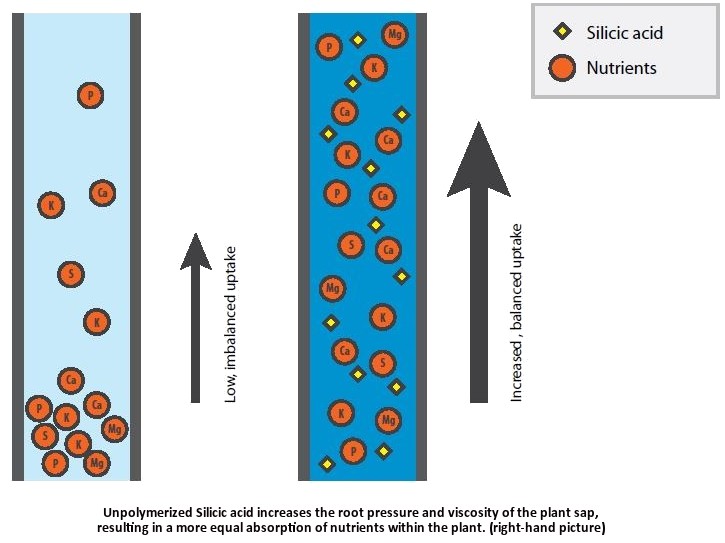
The uptake and deposition of silicic acid varies greatly between plant species. Silicon tissue concentrations in plants such as rice, sugarcane, and some grasses are as high as 10% dry weight. Needless to say that 10% more dry weight equals 10% more yield equals 10% more profit.
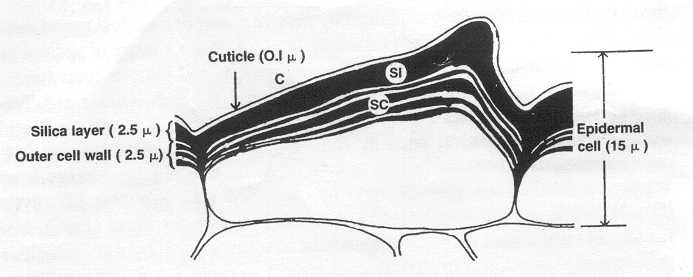
Silicon’s mechanical barrier giving you next to a stronger protective layer against infections, more yield in terms of more dry weight through Silicon deposits. (Yoshida S., 1975 The physiology of silicon in Rice. Tech. Bull., Food Fert. Tech. Centr., Taiwan)
Another benefit of treating plants with monosilicic acid is their increased capacity to cope with stress. Research has shown that in cases of induced heat stress with temperatures up to 40° C, plants treated with silicon still thrived, where the untreated ones were visibly suffering. Also in cases of drought stress and stress caused by high concentrations of salts in the substrate (high EC), it was clear that silicon-treated plants suffered a lot less than the untreated ones.
Conventional agriculture, characterized by the use of synthetic chemicals, is responsible for weak and sick crops, which makes them a potential target for opportunistic pests and diseases. On top of that insects, fungi and weeds only become more and more resistant against insecticides, fungicides and herbicides over time. The only countermeasure conventional agriculture applies, is increasing the concentrations of these same chemicals. This creates an endless downward spiral which makes many growers feel helpless against the onslaught of spiders mites, thrips, powdery mildew, aphids, and other crop destroyers. There is a more natural way of tackling this problem: ‘bioavailable silicon’. The thickest layer of silicon is deposited just underneath the outer layer of cells (epidermis), which is in direct contact with its environment. This layer of silicon makes it very hard for insects or fungi to penetrate.
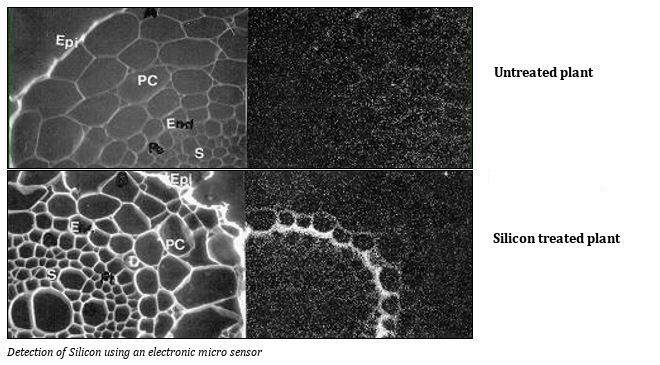
When a plant is attacked for instance by fungi and its cell wall is partially penetrated, you will see, in cases where there is sufficient free moving silicon present, that this free silicon concentrates itself around the infested spot. By building a fortress around this infested spot, the plant protects itself from further infestation. As a second line of defence the plant will also construct a mineral protection layer to resist attacks by pests or fungi.
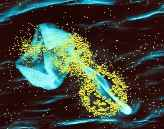
Following a fungal infection, higher concentrations of silicon accumulate around the infected area.
Silicon deposits around mildew spores on cucumber leaves (Laval University Canada, 2006)
Looking at the total picture, the conclusion can be drawn that plants that frequently enjoyed a sufficient dose of monosilicic acid:
- Have stronger and thicker branches
- Are more compact with shorter internodes
- Reach a higher brix-level and higher mineral content
- Carry sturdier fruits with a higher nutritional value and a longer shelf-life
- Are practically not vulnerable to attacks by pests or fungi
- Are more resistant to higher temperatures
- Are more resistant to drought stress
- Are more resistant to stress caused by high concentrations of salts in the substrate (high EC)
- Are better and more equally mineralised, which strongly minimalizes the chance of plant deficiencies
- Give a bigger yield
When monosilicic acid is being converted out of a silicate in a natural way, this only lasts for a short period of time. Monosilicic acid is not stabile and easily converts back into a non-absorbable form of silicate. A couple of years back Aptus succeeded in developing the first specific formulas for producing a stable form of monosilicic acid that can be absorbed by plants within hours. This patented formula was made available for the consumer market under the name “Aptus Regulator”.
Over the years Aptus Regulator has proven itself to be an extremely valuable product, satisfying growers all over the world.If you choose to have healthier, stronger plants and want to achieve a higher yield of better quality……..you choose Aptus Regulator.
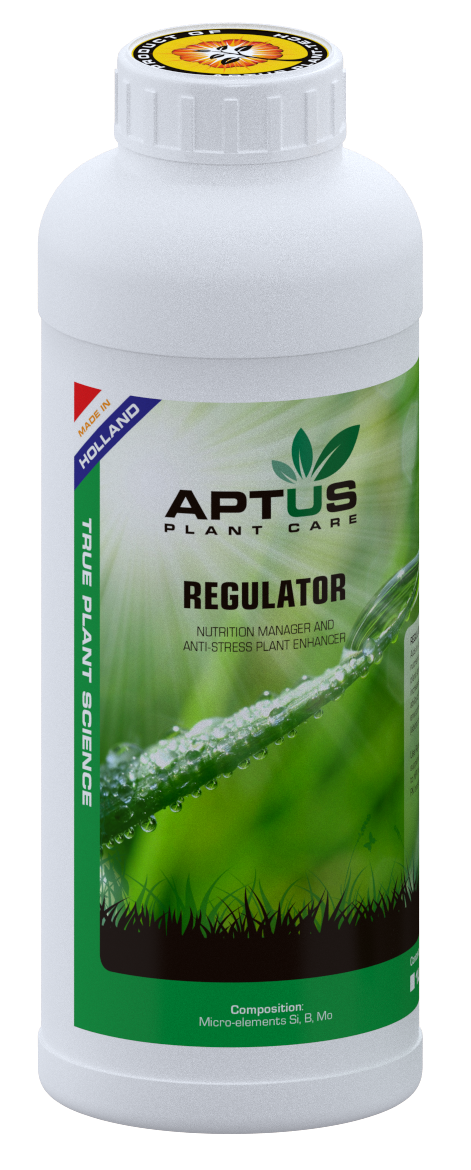





Comments (1)